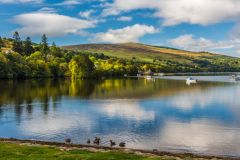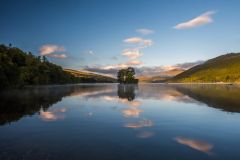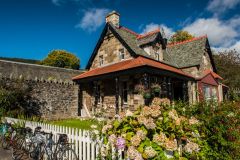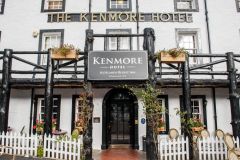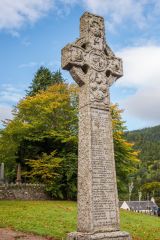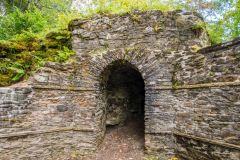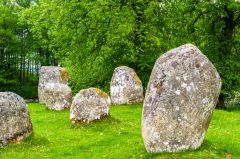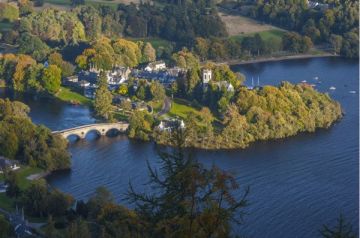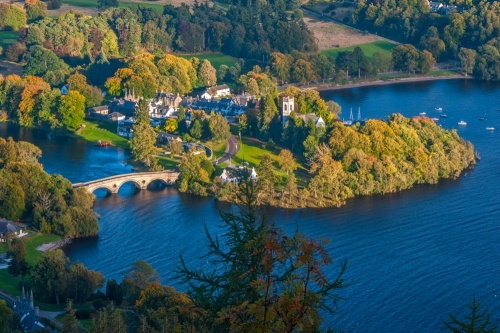
Kenmore is a picturesque village at the north-eastern tip of Loch Tay, set in some of Scotland's most beautiful countryside. The village sits astride the River Tay, which flows out of the loch on its way to Perth and the sea. Given its picture-perfect location on the loch, it is no surprise that Kenmore has a reputation as an ideal centre for water sports such as canoeing, sailing, and water-skiing.
History
The village is centred on The Square, with the parish church at one end and the gates of Taymouth Castle at the other. In between is a terrace of attractive cottages and the historic Kenmore Hotel, Scotland's oldest inn, founded as a tavern in 1502 and converted to a hotel in 1572 by Laird Colin Campbell. The striking porch is supported on age-blackened tree trunks.
In the 17th century hotel welcomed (or perhaps 'endured' is more apt) a visit from Oliver Cromwell and his soldiers. Cromwell and his men dined here whilst pursuing the Earl of Montrose. They must have enjoyed their meal, for they spared the hotel rather than burning it down as they did to many other buildings in the region.
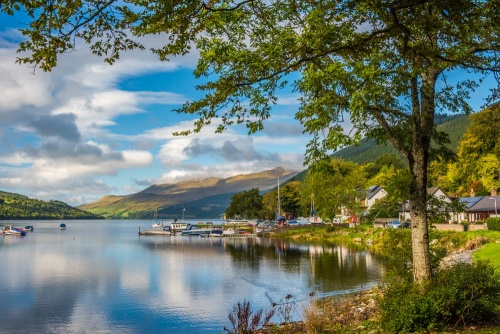
Centuries later poet Robert Burns visited the village and was so moved by the beauty of the place that he wrote a poem directly onto the chimney breast of the fireplace in what is now Poet's Bar.
'Admiring Nature in her wildest grace,
These northern scenes with weary feet I trace'
Burns was followed decades later by William Wordsworth and his sister Dorothy. The later remarked in her diary that 'When we came in view of the foot of the lake, we perceived that it ended, as it had begun, in pride and loveliness'. She did, however, go on to say the preferred Killin at the other end o the loch!
Later still, Queen Victoria and Prince Albert spent part of their honeymoon at the Kenmore Hotel.
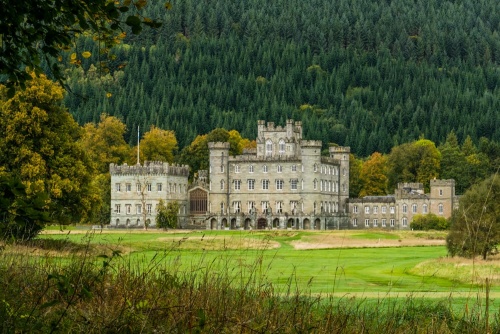
The history of Kenmore goes back long before Queen Victoria wrote gushing plaudits in her journals. The first settlement was at Inchadney on the north side of the River Tay, two miles from its current site. In 1540 Sir Colin Campbell of Glenorchy built Balloch Castle at the north-eastern tip of Loch Tay and the village was moved to a headland on the loch shore.
Like the castle, the village was known as Balloch from the Gaelic word for a pass. The name was later changed to Kenmore, a combination of Gaelic words meaning a large head (for the headland). Another interpretation suggests that Kenmore comes from the Gaelic cean-Mhoire, meaning 'Mary's headland'.
Kenmore, as we see it today, is a model estate village laid out by the 3rd Earl of Breadalbane in 1760. The carefully designed terraces of estate cottages give Kenmore an air of timeless beauty. The village centre has been declared a conservation area in an effort to preserve Kenmore's traditional appearance.
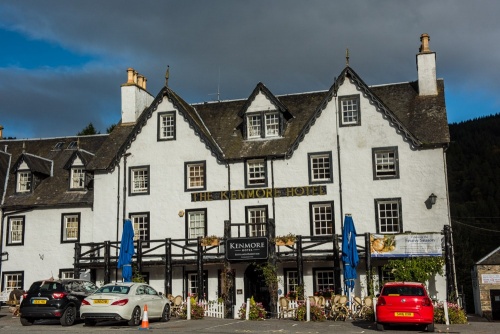
As for Balloch Castle, it was pulled down in 1805 and replaced by a massive mansion in neo-Gothic style known as Taymouth Castle. Though the castle is privately owned, there are public footpaths through the estate, which take you through 18th-century landscaped grounds including several romantic landscape features and follies.
Visible from the shore of Loch Tay is a large island known as The Isle of the Holy Women (Eilean nam Ban-naomh). The name gives a clue to its history, for it was here that a 12th-century nunnery was established. Queen Sybilla (d 1122), wife of Alexander I of Scotland is buried on the island. The nunnery was replaced by a castle in the late medieval period but little now remains of the fortifications.
Kenmore Church
The striking whitewashed church stands at the western end of The Square. The tower dates to 1760 and houses a bell cast in London in 1763. The church was designed by William Baker of Cheshire for the 3rd Earl of Breadalbane at a cost of six guineas. The 18th-century church incorporated parts of an earlier 1669 building on the same site.
In the churchyard is the grave of an infant son of Maharajah Duleep Singh, the last ruler of the Sikh empire. Duleep Singh was exiled when the East India Company took over his kingdom in 1849. His infant son was only one day old when he died in 1865 and was buried at Kenmore.
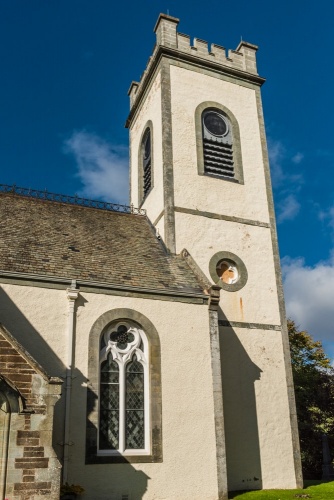
Scottish Crannog Centre
A mile from the village centre on the southern side of the loch is the Scottish Crannog Centre, where you can explore an authentic recreation of a 2500-year-old crannog on a manmade island reached by a causeway. Visitors can learn what life was like for crannog-dwellers and try their hand at traditional crafts.
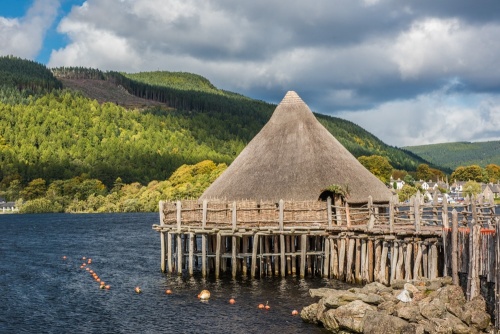
Acharn Hermitage and Falls
If you carry on down the minor road beyond the Crannog Centre you will reach the hamlet of Acharn. A footpath from the village centre leads you up a steep trail beside Acharn Water. After almost a mile you come to the Acharn Hermitage, a manmade cave leading to a viewing platform looking towards Acharn Falls.
The 'hermitage' was built by the Earl of Breadalbane in the 18th century. It was meant to be a Gothic folly, evoking classical images of an ancient cave, the home of a holy man. Visitors passing through the darkness of the cave would emerge suddenly at the viewing platform for a dramatic view of the waterfall across the gorge.
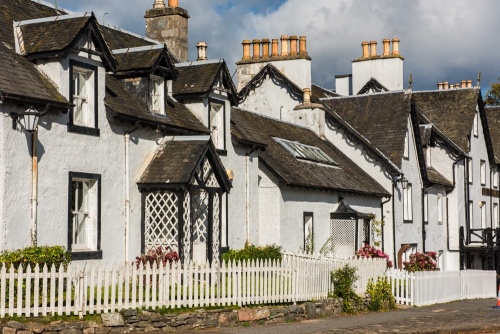
Croft Moraig Stone Circle
Just two miles east of Kenmore on the A827 road to Aberfeldy is a small stone circle at Croftmoraig. The circle was built in three phases spread out over 1000 years, beginning at least as early as 3000 BC. This complex site includes recumbent stones, a graded arrangement of stones in a roughly circular shape, and an outer earthwork ring. The stones may be placed to mark an astronomical alignment.
Bolfracks Garden
Near Croft Moraig is Bolfracks Garden, a beautiful hillside garden arranged around an 18th-century house, once used by the factor of Taymouth Castle.
A stream garden follows the course of Bolfracks Burn and there are distinct terraced garden areas including a rose garden and long herbaceous borders. At the heart of the garden is a Menzies family mausoleum. Bolfracks is excellent for rare and unusual plants such as old-fashioned roses and moisture-loving plants.
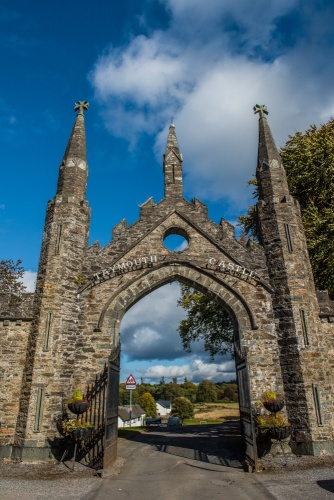
Drummond Hill
Above Kenmore to the north is Drummond Hill, part of the Tay Forest Park. The Forestry Commission Scotland maintains three waymarked trails through the woodlands here. One trail takes you to Black Rock viewpoint, which offers superb views over Loch Tay and Kenmore village. The going is strenuous but the view from Black Rock makes your exertions worthwhile. A longer trail takes you to Caisteal MacTuathal, a Pictish hill fort named for Tuathal, a 9th-century son of the abbot of Dunkeld.
Drummond Hill was probably the first managed forest in Scotland. In the 17th century Sir Duncan Campbell of Breadalbane (known to history as Black Duncan for his unsavoury character) planted the hill with a mix of Scots pine, oak and birch.
Nearby
Fortingall Yew
Just north of Loch Tay is Glen Lyon. At the eastern end of the glen is the pretty village of Fortingall. In the churchyard at Fortingall is the Fortingall Yew, traditionally said to be 5000 years old and the oldest living thing in Europe.
More recent research suggests it is more likely to be 2000 years old. In the 18th century visitors came in droves to see the yew and many took a cutting of the wood as a souvenir. The tree was in danger of being destroyed so it was enclosed within a stone wall for preservation.
Ben Lawers
From the beach at Kenmore you can look down Loch Tay towards the peak of Ben Lawers, one of Scotland's most popular Munros (mountains over 3000 feet high). The mountain is part of the Ben Lawers Nature Reserve, which includes a nature trail taking in rare and unusual plants surrounding Erdamucky Burn. The trail extends to the ruins of old shielings built by shepherds. The Ben Lawers Nature Reserve is maintained by the National Trust for Scotland.
About Kenmore, Perthshire
Address: Kenmore,
Perthshire,
Scotland
Attraction Type: Village
Location: On the A827 at the north-eastern tip of Loch Tay. Free parking in the village centre and in a layby by the beach.
Location map
OS: NN773454
Photo Credit: David Ross and Britain Express
HERITAGE
 We've 'tagged' this attraction information to help you find related historic attractions and learn more about major time periods mentioned.
We've 'tagged' this attraction information to help you find related historic attractions and learn more about major time periods mentioned.
Find other attractions tagged with:
NEARBY HISTORIC ATTRACTIONS
Heritage Rated from 1- 5 (low to exceptional) on historic interest
Taymouth Castle Estate Walk - 0 miles (Historic Building) ![]()
Scottish Crannog Centre - 0.4 miles (Museum) ![]()
Acharn Hermitage - 1.7 miles (Historic Building) ![]()
Fortingall Yew & Church - 2.1 miles (Historic Church) ![]()
General David Stewart Memorial - 2.3 miles (Historic Building) ![]()
Croft Moraig Stone Circle - 3 miles (Prehistoric Site) ![]()
Dull Cross - 3.1 miles (Prehistoric Site) ![]()
Bolfracks Garden - 4 miles (Garden) ![]()
